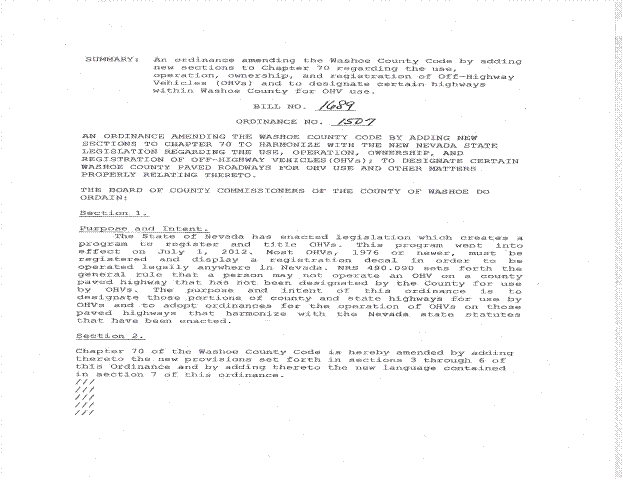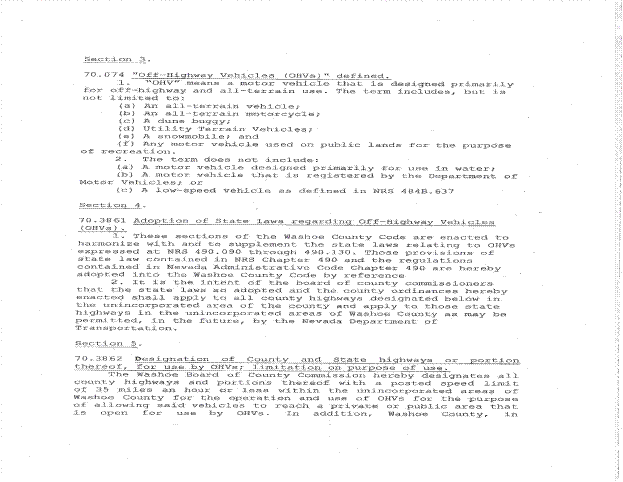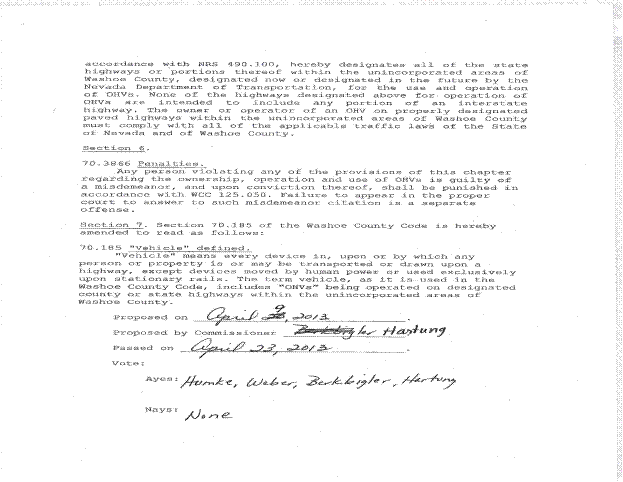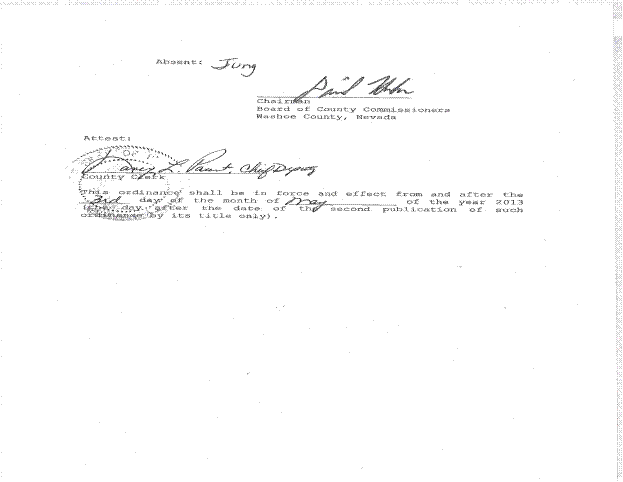OHV laws and regulations: updated state and local laws/regulations for large OHVs
From Nevada Revised Statutes Chapter 490 - Off Highway Vehicles
NRS 490.043 “Large all-terrain vehicle” defined. “Large all-terrain vehicle” means any all-terrain vehicle that includes seating capacity for at least two people abreast and:
1. Total seating capacity for at least four people; or
2. A truck bed.
(Added to NRS by 2013, 704)
NRS 490.060 “Off-highway vehicle” defined.
1. “Off-highway vehicle” means a motor vehicle that is designed primarily for off-highway and all-terrain use. The term includes, but is not limited to:
(a) An all-terrain vehicle, including, without limitation, a large all-terrain vehicle without regard to whether that large all-terrain vehicle is registered by the Department in accordance with NRS 490.0825 as a motor vehicle intended to be operated upon the highways of this State;
(b) An all-terrain motorcycle;
(c) A dune buggy;
(d) A snowmobile; and
(e) Any motor vehicle used on public lands for the purpose of recreation.
2. The term does not include:
(a) A motor vehicle designed primarily for use in water;
(b) A motor vehicle that is registered by the Department in accordance with chapter 482 of NRS;
(c) A low-speed vehicle as defined in NRS 484B.637; or
(d) Special mobile equipment, as defined in NRS 482.123.
(Added to NRS by 2005, 2025; A 2009, 3102; 2011, 292; 2013, 705)
NRS 490.0825 Large all-terrain vehicle: Alternative registration; requirement for insurance; documents required.
1. Upon the request of an owner of a large all-terrain vehicle, the Department shall register the large all-terrain vehicle to operate on the roads specified in NRS 490.105.
2. The owner of a large all-terrain vehicle wishing to apply for registration or renewal of registration pursuant to this section must obtain and maintain insurance on the vehicle that meets the requirements of NRS 485.185.
3. If an owner of a large all-terrain vehicle applies to the Department for the registration of the vehicle pursuant to this section, the owner shall submit to the Department:
(a) The information required for registration pursuant to NRS 490.082;
(b) The fee for registration required pursuant to NRS 490.084;
(c) Proof satisfactory to the Department that the applicant carries insurance on the vehicle provided by an insurance company licensed by the Division of Insurance of the Department of Business and Industry and approved to do business in this State which meets the requirements of NRS 485.185; and
(d) A declaration signed by the applicant that he or she will maintain the insurance required by this section during the period of registration.
(Added to NRS by 2013, 704)
NRS 490.090 Operation on undesignated paved highways generally prohibited; exceptions; operation on public land, trails, ways or unpaved county roads authorized unless prohibited by governmental entity having jurisdiction; authority of governmental entities having jurisdiction to distribute information concerning prohibited areas and to erect signs designating prohibited areas. Except as otherwise provided in NRS 490.100 or 490.110:
1. A person shall not, except as otherwise provided in subsection 2 or 3, operate an off-highway vehicle on a paved highway that is not otherwise designated for use by off-highway vehicles.
2. A person may operate an off-highway vehicle on a paved highway that is not otherwise designated for use by off-highway vehicles:
(a) If the off-highway vehicle is operated on the highway for the purpose of crossing the highway, comes to a complete stop before crossing and crosses as close as practicable to perpendicular to the direction of travel on the highway;
(b) If the off-highway vehicle is operated on the highway for the purpose of loading or unloading the off-highway vehicle onto or off of another vehicle or trailer, if the loading or unloading is as close as practicable to the place of operation of the off-highway vehicle;
(c) During an emergency if it is impossible or impracticable to use another vehicle or if a peace officer directs the operation of the off-highway vehicle; or
(d) If the off-highway vehicle is operated on a portion of a highway that is designated as a trail connector for a trail authorized for use by off-highway vehicles for not more than 2 miles.
3. A person may operate an off-highway vehicle on any public land, trail, way or unpaved county road unless prohibited by the governmental entity which has jurisdiction over the public land, trail, way or unpaved county road.
4. A governmental entity specified in subsection 3 may:
(a) Prepare and distribute upon request a map or other document setting forth each area of public land, trail, way or unpaved county road that is prohibited for the operation off-highway vehicles; and
(b) Erect and maintain signs designating each area of public land, trail, way or unpaved county road that is prohibited for the operation off-highway vehicles.
(Added to NRS by 2005, 2027)
NRS 490.100 Authority of city or county to designate portion of highway for off-highway vehicle use; approval of Department of Transportation regarding state highways; interstate highways excluded; supervision of certain minors; limitation on purpose of use.
1. Except as otherwise provided in subsection 2, a city or county may designate any portion of a highway within the city or county as permissible for the operation of off-highway vehicles for the purpose of allowing off-highway vehicles to reach a private or public area that is open for use by off-highway vehicles. If a city or county designates any portion of a state highway as permissible for the operation of off-highway vehicles pursuant to this subsection, the city or county must obtain approval for the designation from the Department of Transportation. The Department of Transportation shall issue a timely decision concerning the request for approval and must not unreasonably deny the request.
2. The highway designated for operation of off-highway vehicles pursuant to subsection 1 may not consist of any portion of an interstate highway.
3. If a city or county designates a highway for the operation of off-highway vehicles, the city or county may adopt an ordinance requiring a person who is less than 16 years of age and who is operating the off-highway vehicle on a designated highway to be under the direct visual supervision of a person who is at least 18 years of age.
4. A person operating an off-highway vehicle on a highway designated for operation of off-highway vehicles pursuant to subsection 1 may not operate the off-highway vehicle on the highway for any purpose other than to travel to or from the private or public area as described in subsection 1.
(Added to NRS by 2005, 2027; A 2009, 3103; 2011, 293)
NRS 490.105 Large all-terrain vehicle: Operation on certain roads authorized; conditions; local governing body may prohibit by ordinance or resolution.
1. Except as otherwise provided in subsection 2, a person may operate a large all-terrain vehicle on any portion of a highway that has been designated in accordance with NRS 403.170 as a general county road or minor county road if the large all-terrain vehicle:
(a) Meets the requirements set forth in NRS 490.120; and
(b) Is registered by the Department in accordance with NRS 490.0825 as a motor vehicle intended to be operated upon the highways of this State.
2. The governing body of a city or county within which is located a highway or portion of a highway that has been designated in accordance with NRS 403.170 as a general county road or minor county road may by ordinance or resolution prohibit the operation of large all-terrain vehicles on any portion of such a road.
(Added to NRS by 2013, 704)
NRS 490.110 Authorized and unauthorized operation on highway.
1. Except as otherwise provided in subsection 2, if an off-highway vehicle meets the requirements of this chapter and the operator holds a valid driver’s license and operates the off-highway vehicle in accordance with the requirements of those sections, the off-highway vehicle may be operated on a highway in accordance with NRS 490.090 to 490.130, inclusive.
2. An off-highway vehicle may not be operated pursuant to this section:
(a) On an interstate highway;
(b) On a paved highway in this State for more than 2 miles;
(c) Unless the highway is specifically designated for use by off-highway vehicles in a city whose population is 100,000 or more; or
(d) Unless it is a large all-terrain vehicle registered pursuant to NRS 490.0825 and being operated in accordance with NRS 490.105.
(Added to NRS by 2005, 2028; A 2013, 709)
NRS 403.170 Designation of main, general and minor county roads; immunity of State and county from liability resulting from use of minor county roads; reclassification and abandonment of roads; hearing.
1. The board of county highway commissioners of each of the several counties of the State of Nevada shall:
(a) Lay out and designate which of the roads, generally termed public highways, are the most important to the people of the whole county and over which there is the greatest amount of general public travel and shall designate these roads as main county roads.
(b) Lay out and designate other roads of the county over which there is general public travel, and which are generally termed county roads, and shall designate these roads as general county roads.
(c) Lay out and designate other roads which are neither main nor general county roads but have been established by usage, or were constructed for use by the public, and shall designate these roads as minor county roads. This section does not require any maintenance for minor county roads. The State and the county are immune from liability for damages suffered by a person as a result of using any road designated as a minor county road.
2. The board of county highway commissioners may, from time to time, reclassify the roads and may lay out new roads of any class, or the board may change or abandon any roads termed as public highways.
3. The designation of a new road as a main county road, as a general county road or as a minor county road, or the reclassification of any road, or the abandonment of any road does not become effective until after a public hearing is held at which parties in interest and citizens have an opportunity to be heard. At least 10 days’ notice of the time and place of the hearing must be published in a newspaper of general circulation in the county.
[1: Art. 4:257:1913; 1919 RL p. 2903; NCL § 5375]—(NRS A 1979, 1173; 1993, 1399)
Washoe County Ordinance #1507:




